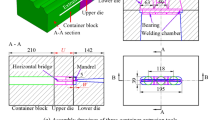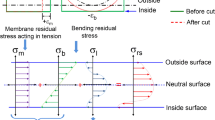Abstract
In this study, a new rolling–extrusion technology implementing plastic deformation is presented for the forming of the hollow cylindrical component, and the design criterion of the rollers with changeable internal diameter is introduced based on the prediction of the forward slip value. Moreover, in order to investigate the feasibility of this technology, a finite element (FE) simulation and an experiment are conducted. The result of the FE simulation shows that: the metal flow is caused only in the area where the rollers contact the billet, and influenced by the heat exchange between the billet and the rollers; a set of most reasonable technological parameters is selected through an evaluation of the deformation uniformity of 18 groups of simulations. In addition, the result of the experiment shows that the hollow cylindrical component can be formed, and the consumption for the material of each component can be saved at least 16.8 %.
Similar content being viewed by others
References
Zhang ZM, Huang SD, Liu CL, Chen J, Zhuang XC, Fu Y, Zhao ZX, Wang YB (2010) The forming process of projectile development and practice of digital design system. J Precis Form Eng 2:55–59 (In Chinese)
Bai Q, Yang H, Zhan M (2007) Effect of the mandrel rotary velocity on spinning of thin-walled curvilinear generatrix shell with hoop inner rib. Proceedings of The Fifth International Conference on Physical and Numerical Simulation of Materials Processing. 674–679
Kawai K, Yang LN, Kudo H (2007) A flexible shear spinning of axi-symmetrical shells with a general-purpose mandrel. J Mater Process Technol 192:13–17
Quigley E, Monaghan J (2000) Metal forming: an analysis of spinning processes. J Mater Process Technol 103:114–119
Wong CC, Dean TA, Lin J (2003) A review of spinning, shear forming and flow forming processes. Int J Mach Tool Manuf 43:1419–1435
Prakash R, Singhal RP (1995) Shear spinning technology for manufacture of long thin wall tubes of small bore. J Mater Process Technol 54:186–192
Jiang SY, Zheng YF, Ren ZY, Li CF (2009) Multi-pass spinning of thin-walled tubular part with longitudinal inner ribs. Trans Nonferrous Metals Soc China 19(1):215–221
Davidson MJ, Balasubramanian K, Tagore GRN (2008) An experimental study on the quality of flow-formed AA6061tubes. J Mater Process Technol 203:321–325
Xia QX, Cheng XQ, Hu Y, Ruan F (2006) Finite element simulation and experimental investigation on the forming forces of 3D non-axisymmetrical tubes spinning. Int J Mech Sci 48:726–735
Liu JH, Yang H, Li YQ (2002) A study of stress and strain distribution of first-pass conventional spinning under different roller traces. J Mater Process Technol 129:326–329
Xue KM, Lü Y (1997) Elastic-plastic FEM analysis and experimental study of diametral growth in tube spinning. J Mater Process Technol 69:172–175
Molladavoudi HR, Djavanroodi F (2011) Experimental study of thickness reduction effects on mechanical properties and spinning accuracy of aluminum 7075 during flow forming. Int J Adv Manuf Technol 52(9–12):949–957
Ma F, Yang H, Zhan M (2010) Effects of material properties on power spinning process of parts with transverse inner rib. Trans Nonferrous Metals Soc China 20(8):1476–1481
Song YQ (2000) The prospect of successive partial plastic forming. Chin Mech Eng 11(1/2):65–67
Quigley E, Monaghan J (2002) The finite element modelling of conventional spinning using multi-domain models. J Mater Process Technol 124(3):360–365
Liu CH (2007) The simulation of the multi-pass and die-less spinning process. J Mater Process Technol 192:518–524
Zhan M, Yang H, Zhang JH (2007) Establishment of 3D FEM model of multi-pass spinning. Chin J Mech Eng 20(4):19–23
Bai Q, Yang H, Zhan M (2008) Finite element modeling of power spinning of thin-walled shell with hoop inner rib. Trans Nonferrous Metals Soc China 18:6–13
Lof J (2001) Elasto-viscoplastic FEM simulations of the aluminum flow in the bearing area for extrusion of thin-walled sections. J Mater Process Technol 114:174–183
Lof J, Blokhuis Y (2002) FEM simulation of the extrusion of complex thin-walled aluminum sections. J Mater Process Technol 122:344–354
Song JL, Dowson AL, Jacobs MH, Brooks J, Beden L (2002) Coupled thermo-mechanical finite element modeling of hot ring rolling process. J Mater Process Technol 121:332–340
Xu SG, Weinmam KJ, Yang DY, Lian JC (1997) Simulation of the hot ring rolling process by using a thermo-coupled three dimensional rigid-viscoplastic finite element method. J Manuf Sci Eng 119:542–549
Wang MR, Li XT, Du FS, Zheng YZ (2005) A coupled thermal-mechanical and microstructural simulation of the cross wedge rolling process and experimental verification. Mater Sci Eng A 391:305–312
Zhao X, Zhang ZM, Zhang BH (2013) Research on the forward slip of rolling-extrusion forming for variable wall thickness cylinder parts. J Chem Pharm Res 5(9):549–554
Zhao X, Zhang ZM, Zhang BH (2013) Finite element simulation on rolling-extrusion forming of variable wall thickness cylinder parts. J Chem Pharm Res 5:536–541
Zhang J, Zhang YC, Huang SD (2011) Simulation of static recrystallization behavior of 58SiMn steel. Chin J Mech Eng 24(3):446–451
Zhao X, Zhang ZM, Zhang BH (2014) Research on rolling–extrusion forming of variable wall thickness cylinder parts. Mater Res Innov 18(S2):940–945
Author information
Authors and Affiliations
Corresponding author
Rights and permissions
About this article
Cite this article
Zhao, X., Wu, H. & Zhang, Z. A new rolling–extrusion technology for the forming of the hollow cylindrical component. Int J Adv Manuf Technol 86, 1127–1136 (2016). https://doi.org/10.1007/s00170-016-8573-9
Received:
Accepted:
Published:
Issue Date:
DOI: https://doi.org/10.1007/s00170-016-8573-9




